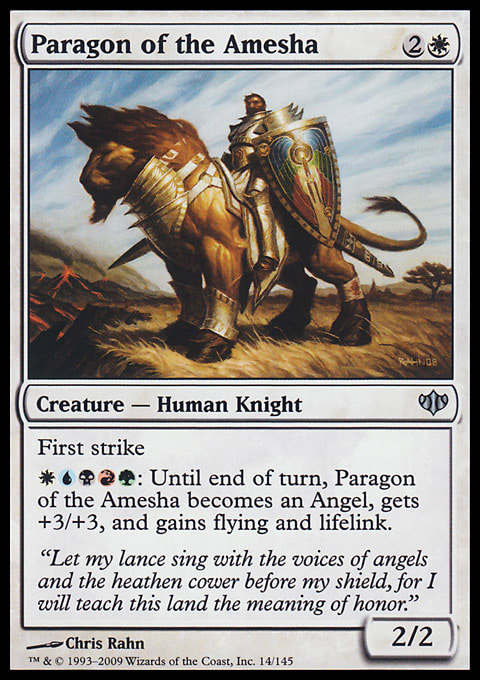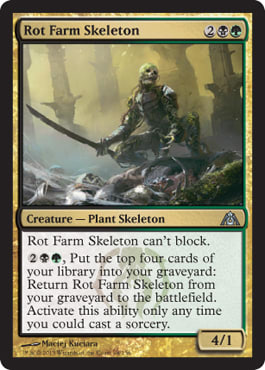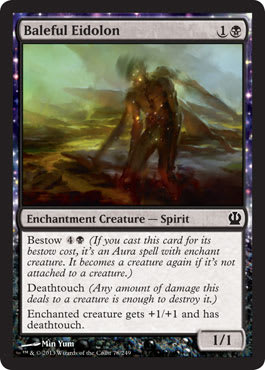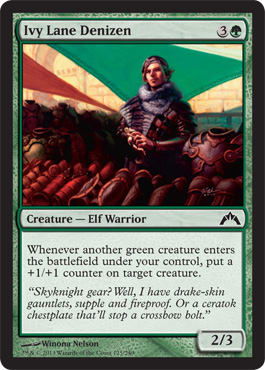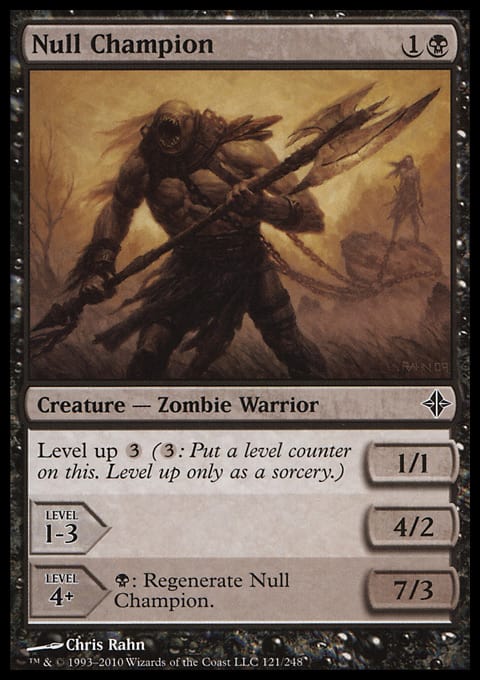In this experiment, we fill our graveyard with trash while bringing our commander back, turn after turn, for only 4 mana.
Commander (2013 Edition) brought us a legendary creature that can return to the battlefield repeatedly for only 4 mana, so Derevi, Empyrial Tactician would be a pretty good guess of the creature to which I was referring. However, today, instead of going over my normal style of combo deck, I’ll take a look into the realm of Pauper Commander. The “trash” we’ll be filling our graveyard with is commons. As they say, one man’s trash is another man’s treasure, and judging from how many stack of commons are left on Draft tables, I think the phrase makes for a fine description of Pauper Commander’s bread-and-butter card rarity.
With the popularity of Commander and the popularity of budget Magic play, finding people to play with shouldn’t be too difficult. A couple weeks ago, Abe Sargent wrote about one of his multiple budget Commander lists; last week, Mike Cannon covered a rareless Commander deck; and on DailyMTG last week, Bruce Richard wrote about ways to include players with smaller collections. Somewhere in all of this, I found my way to an exhaustive Pauper Commander site, and the relative ease of building a deck—combined with the additional deck-building options presented—was quite tempting.
I almost immediately decided I wanted to play with either Paragon of the Amesha or Dragonsoul Knight, both of which are cards I’ve always thought were awesome but which I’ve never had a reason to play with. Using only commons I had lying in easily-accessible piles, I built a relatively themeless five-colored deck. Upon hearing I had built such a deck, a friend of mine put together a Spellheart Chimera deck with little effort, and we were able to play a one-on-one duel on my weekly Magic night. This just goes to show the ease and attractiveness of the format, but if you weren’t sold from the description, I’m probably wasting my word count.
Anyway, in addition to my themeless five-colored deck, I couldn’t help but brew up something a bit spicier. I started by looking through a ton of uncommon creatures as options. In Pauper Commander, all uncommon creatures are eligible commanders, so there were a lot of choices for me to consider. I made a list of a bunch that seemed great, but one, in my second-favorite two-colored combination, stuck out.
Rot Farm Skeleton is a card that can do a lot of work but that was pretty color- and mana-intensive for a Limited format that didn’t actually have too much graveyard synergy—and that ended up rewarding two-colored decks more than three-or-more-colored decks. It didn’t help that Golgari was relatively weak. However, as a commander, the Skeleton is always accessible from the start, and in not taking advantage of the command zone after the initial casting, we can let the Skeleton go to our graveyard for its ability to be activated. Cast it, let it die—possibly abusing it for a sacrifice effect—and then return it while milling four cards. With ways to benefit from our graveyard, it’s all upside from there.
I ended up looking through every single common card that fits the Golgari color identity, and I narrowed my possible decklist down to about one hundred sixty cards. It was pretty rough taking one hundred or so off from there in order to finalize the list below. Some examples of cards that were left on the cutting board floor—but that would still make great inclusions—are Morgue Theft, Acorn Harvest, Golgari Brownscale, and Cabal Surgeon.
"Pauper Rot Farm"
- Commander (0)
- Creatures (36)
- 1 Baleful Eidolon
- 1 Basilica Screecher
- 1 Battlefield Scrounger
- 1 Blight Mamba
- 1 Cabal Torturer
- 1 Cavern Lampad
- 1 Citanul Woodreaders
- 1 Crocanura
- 1 Crypt Rats
- 1 Cytospawn Shambler
- 1 Dimir House Guard
- 1 Fa'adiyah Seer
- 1 Gray Merchant of Asphodel
- 1 Heartstabber Mosquito
- 1 Ivy Lane Denizen
- 1 Krosan Tusker
- 1 Liliana's Shade
- 1 Maul Splicer
- 1 Mold Shambler
- 1 Nessian Asp
- 1 Null Champion
- 1 Quag Vampires
- 1 Quagmire Druid
- 1 Sewer Shambler
- 1 Shambling Shell
- 1 Sluiceway Scorpion
- 1 Smokespew Invoker
- 1 Sporemound
- 1 Stinkweed Imp
- 1 Terrus Wurm
- 1 Thrashing Mossdog
- 1 Twisted Abomination
- 1 Ulamog's Crusher
- 1 Urborg Syphon-Mage
- 1 Wildheart Invoker
- 1 Yavimaya Elder
- Spells (29)
- 1 Altar's Reap
- 1 Death Denied
- 1 Echoing Decay
- 1 Elephant Ambush
- 1 Ghastly Demise
- 1 Gnaw to the Bone
- 1 Gravepurge
- 1 Launch Party
- 1 Soulshriek
- 1 Sprout Swarm
- 1 Bone Splinters
- 1 Crippling Fatigue
- 1 Dirge of Dread
- 1 Disturbed Burial
- 1 Evincar's Justice
- 1 Far Wanderings
- 1 Urborg Uprising
- 1 Moldervine Cloak
- 1 Night Soil
- 1 Pestilence
- 1 Rancor
- 1 Snake Umbra
- 1 Tortured Existence
- 1 Blight Sickle
- 1 Fleetfeather Sandals
- 1 Golgari Cluestone
- 1 Golgari Signet
- 1 Pristine Talisman
- 1 Vulshok Morningstar
- Lands (34)
- 12 Forest
- 12 Swamp
- 1 Bojuka Bog
- 1 Command Tower
- 1 Evolving Wilds
- 1 Golgari Guildgate
- 1 Golgari Rot Farm
- 1 Haunted Fengraf
- 1 Jund Panorama
- 1 Khalni Garden
- 1 Quicksand
- 1 Terramorphic Expanse
With the list above, I’ll go through several of the individual cards to share my thoughts.
Baleful Eidolon – This card seems wonderful. It’s been only gaining popularity in Theros Limited, and its usefulness in Pauper Commander is just as potent I think, if not more so. Note that one of the assumptions I made about the format, though I haven’t played much of it, is that games will often stall out to a degree. That means Rattlesnake cards, which deter opponents from attacking us, will be more valuable. Evasion and noncombat win conditions will also be quite useful if my assumption is correct.
Basilica Screecher and Pristine Talisman – If games do go long, incidental and repeatable life-gain will create huge advantages for players who are ahead by 10 to 20 life when some kind of fallout does occur—or in evasion-based attrition battles of life points. Basilica Screecher has the advantage of serving as a potential noncombat win condition as well, though it does put a big target on both its and your head. Pristine Talisman seems valuable for Pauper Commander decks of all kinds.
Blight Mamba and Blight Sickle – There were several good pieces of Equipment I thought were worth including in a Pauper Commander deck, but as I said, I had to cut a lot of cards. Blight Sickle has the big advantage that it can eventually slice through any opposition. With a commander that returns potentially every turn and with multiple creatures with regeneration, the Sickle provides us inevitability in our attacks. The Mamba has similar benefits, though it makes a great blocker, shrinking the attackers every time. It also grants us the option for a poison-based victory.
Cabal Torturer, Smokespew Invoker, Urborg Syphon-Mage, Ivy Lane Denizen, Sporemound, Disturbed Burial, Night Soil, Rancor, Tortured Existence – This long list of seemingly-unrelated cards represents some of the commons that provide us repeated advantages over the course of the game. The major flaw of most commons is that they function on a smaller scale than rares and uncommons do—there are many one-shot effects with little opportunities for card advantage. Finding cards with repeatable effects such as these will break open stalemates.
Citanul Woodreaders and Urborg Uprising – While these cards don’t provide repeatable effects, they do offer notable card advantage in the form of three-for-ones, which common cards don’t often provide.
Crypt Rats, Evincar's Justice, and Pestilence – These are three of the very few Wrath effects available in the format, and if you plan to play a lot of Pauper Commander, I’d expect to see them often. In red, there are also Swirling Sandstorm and Martyr of Ash, and I’m sure there are at least several more I’m not thinking of, but having the power to exert this much power in an all-commons game will be very potent.
Dimir House Guard – My initial opinion of the transmute cards was that they would be quite useful, as I was perusing all the options in my list of black and green commons. As I pruned the list into a deck, however, the toolbox shrunk and shrunk, and so too did the usefulness of the transmute cards. Without key power cards or combo pieces, transmute just lost a lot of its appeal. While Shred Memory for Death Denied could be nice, I decided to just keep Dimir House Guard as a way to find Rot Farm Skeleton in the event it finds its way into our library.
Heartstabber Mosquito – This poor guy was pretty close to the chopping block, but I felt it was important to include a Nekrataal effect. I had both this and Skinthinner, but some stuff had to go, and the Mosquito won the slot both for its flying and for the fact that its total cost to cast and kill a creature is
Null Champion and Quag Vampires – Another type of card I expect to be useful are massive creatures, and versatility is always nice. Null Champion and Zulaport Enforcer can both become huge threats given enough mana. I love the Enforcer for his evasion, but the Null kept his spot for his high power and tenacity. Quag Vampires and Gnarlid Pack are both great, potentially-large creatures as well, scaling to any part of the game. Again, though, I decided one had to go, and I kept the Vampires for the potential evasion.
Ulamog's Crusher and Sprout Swarm – These are two cards I expect are key players in the Pauper Commander format. Any deck can run the Crusher, and like its father and uncle—Ulamog, the Infinite Gyre and Kozilek, Butcher of Truth—its massive relative size and annihilator ability will be quote potent against all competition. The format does have the advantage that the Eldrazi will be susceptible to most removal, however, so it is not as big a deal as the big trio (with the banned Emrakul, the Aeons Torn rounding them out). However, Sprout Swarm is a different story. Short of a counterspell, this Time Spiral–block–Limited–defining card is unstoppable, and given enough time, it will undoubtedly take over a game in a swarm of sprouts.
Altar's Reap, Launch Party, and Bone Splinters – These are the remnants of a list of cards I included to take advantage of Rot Farm Skeleton’s recursive superpower. Putting the Skeleton into our graveyard means we are able to bring him back for 4 mana and mill four more cards, and we also gain the benefit of the less expensive spell’s effect. Other cards I’d hoped to include were, for example, Accursed Centaur, Kjeldoran Dead, and Death Bomb.
Elephant Ambush, Gnaw to the Bone, and Crippling Fatigue – Part of the benefit of filling our graveyard is that we gain access to essentially free cards. For that to work, though, we need cards that take advantage of being in the graveyard. My instinct was to include every card available that had flashback, dredge, unearth, scavenge, or recover. That way, the graveyard would just fill up with extra cards. However, when those extra cards are 2/1s and 3/3s that only last for a single turn or spells that exile a single card from a graveyard, the opportunity cost of running cards that are just better becomes too high. For that reason, Dregscape Zombie, Viscera Dragger, Coffin Purge, Chatter of the Squirrel, and many others just didn’t make the cut. The cards above are some of the ones that did.
Soulshriek and Dirge of Dread – In a stalled-out multiplayer game or one that’s become slightly imbalanced and will probably be ending soon, these cards can make sure things fall in your favor. The format has a lower threshold of commander damage at 16, rather than the usual 21—in addition to its lowered life total of 30, rather than 40—so Soulshriek on the Rot Farm Skeleton with a big graveyard can just take one player out. Just make sure you’re in a position to win from that point. One unfortunate cut was Haunting Misery, which could similarly end the game. I chose Soulshriek because it’s easier to have twelve creatures in the graveyard (the Skeleton’s 4 power plus twelve creatures equals 16 commander damage) than it is to have thirty creatures (to one-shot an opponent with Haunting Misery), but it might make more sense to have the Misery so the Skeleton doesn’t have to try to find a clear window to attack.
In the end, I wish the deck had more creatures, but the spells just seem so useful. I also wish I’d been able to stick closer to the initial plan of including every card with a graveyard ability, but many of the cards are just so weak. Perhaps it could be possible with a very combo-oriented rush strategy of taking advantage of the plethora of low-powered cards . . . but with things like Morbid Hunger clogging up our library, hand, and graveyard, I just don’t see how we’d win while spending 9 mana to drain our opponent for 3.
Andrew Wilson
fissionessence at hotmail dot com
















